One of the most interesting aspects of the noodle as a food has to do with just how much larger the food’s cultural background is when compared to the physical and tangible nature of the food itself. Different societies that have incorporated the noodle into their culinary tradition have absorbed more than just the noodle’s starchy qualities that make it the perfect base for various sauces and meats, but instead have absorbed the traditions of camaraderie, family, and gathering that have become unavoidably associated with it.
To truly understand what noodles means to the cultures that champion their use and consumption, one need look no further than the twin food giants of Italy and China. Both these cultures hold storied places in world of international cuisine, having expanded their reach so far as to have an influence in almost every corner of the world when it comes to food. Their influence has been accompanied with the inexorable introduction of the noodle because of the important role that this food plays in both Italian and Chinese cuisine. The International Pasta Organization’s “The Truth about Pasta” waxes lyrical about the virtues and benefits of consuming this type of food, highlighting the way that pasta provides health and energy without placing undue stress on one’s diet or on the Earth’s environmental resources due to unsustainable farming practices. These benefits are responsible for pasta’s position as a pillar of the Mediterranean diet for the longest time, with versions of pasta existing in the Etrusco-Roman diet as far back as 1 AD, as mentioned in Life in Italy’s “History of Pasta”. While this reflects the importance of healthy and robust food in Italian cuisine, pasta also owes its popularity to the cultural significance that has developed with the dish. The making of fresh pasta involves processes that require a high level of care and precision, which translates to familial love and care due to the large amount of effort some individuals can contribute to give their family’s the best. Chinese food culture mirrors this belief in many ways, as evidenced by the many meanings and cultural connotations around the idea of bing in David Knechtges analysis of Shu Xi’s “Rhapsody on Pasta”. Chinese cuisine at the time had already accepted pasta and acknowledged that the various types of bing present owed itself to unique origins from various villages and towns across the nation. Despite this, bing found itself favoured by all levels of society, holding a unique position as a pillar of Chinese cuisine that was consumed by both villager and emperor. Furthermore, each of these different types of bing are associated with different cultural ceremonies at different types of the year and to celebrate different events, pointing to the ritualistic importance of this food. This cements the cultural significance of the noodle and its variants in Chinese culture, as well as the unavoidable parallels that exist between China and Italy when it comes to the noodle. The noodle and pasta have come to play such an integral role because of a combination of the food’s nourishing qualities and its ritualistic contributions to the act of coming together and the formation of a community.
The importance of the noodle in both Chinese and Italian food has meant that any country that has experienced the influence of these cuisines has been exposed to this food. Considering just how far and wide both these cuisines have spread, it is hard to imagine any country’s cuisine and food being unaffected by the noodles hailing from China and Italy. Indian cuisine is no different, having experienced Chinese influences in its dishes due to the two nations’ proximity and having received Italian food due to the process of globalization.
Much like China, due to extremely large geographical area of the country and its varied topography, India possesses varied regional cuisines. Noodles manifest in a variety of different ways in Indian cuisine, based on the region that it hails from. Oftentimes, these variations revolve around the starch base that the noodles are derived from.
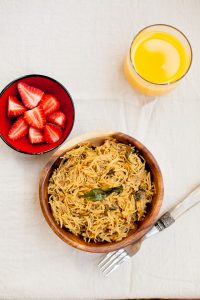
India’s wheat noodles, also known as seviyan, often used in cuisine from the Gujarat region.
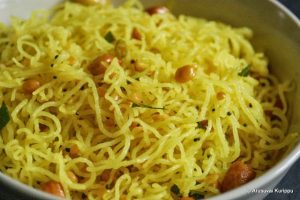
One of the two types of Indian rice noodles, known as sevai, which are first made into an idli pancake before being pressed into the more traditional noodle shape
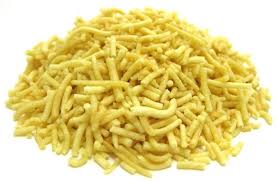
Indian sev, which are a popular munching snack noodle derived from extruded chickpea-flour dough and then fried to make them crisp
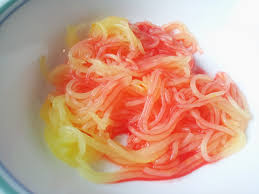
Indian falooda, which are noodles made out of cornstarch and then served with sweetened milk or Indian ice cream known as kulfi
These various Indian cuisine noodles utilize a variety of different starches that are combined with water to create a pasta dough. Thus, when creating a definition that combines Chinese, Italian, and Indian ideas of pasta and the noodle, one must emphasize the importance of both the different starches involved in the process as well as the different methods of preparation once the noodle is formed. A tentative one that expands on the basic definitions provided by the Oxford and Cambridge dictionaries to include these findings has been included below:
The noodle is a piece of pasta created from a combination of a starch (such as flour, cornstarch, rice, etc.) and water, cut into a variety of different shapes, and then prepared using a cooking process that involves a liquid (boiling, stir-frying, steaming, frying, etc.).
While this definition is a clear expansion on the fairly limited versions that both dictionaries have provided, there is still a significant aspect of Indian, Chinese, and Italian noodle culture that fails to be represented. Our analysis of various texts referring to Chinese and Italian noodle culture emphasize the cultural meanings and connotations that invariably accompany the tangible nature of the food. The place that the noodle occupies in Indian culture is the same and is best represented by what virtually every Indian person will point to when asked about Indian noodle culture. The noodle that I am referring to is the Maggi 2-minute noodle that has become an important cultural phenomenon all over India and holds a place as the nation’s favourite comfort food.
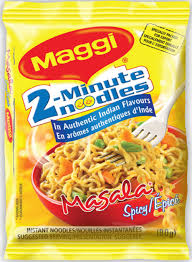
This comfort food is present in a variety of different flavours and noodle types, but the one thing that remains constant is the important role this food plays in the Indian community. People all over the country eat this noodle, lovingly referred to as the nation’s third staple after wheat and rice, available for purchase even in the most remote villages in all regions of India. It exemplifies the companionship and community that is an integral part of the noodle’s cultural significance in China and Italy, providing a common food all over the nation that every Indian can relate to. The cultural significance is made even more obvious when one looks in the bags of every Indian who has to leave the country, as they stock up on Maggi in order to provide them with a quick and easy connection to home whenever they are feeling down. Ultimately, the space that these noodles occupy in Indian food culture showcases the way that this food’s cultural significance has extended past the roles that it plays in Italian and Chinese food culture. With this in mind, I have attempted to provide an expanded definition of the noodle that seeks to incorporate this integral aspect of the noodle:
The noodle is a piece of pasta created from a combination of a starch (such as flour, cornstarch, rice, etc.) and water, cut into a variety of different shapes, and then prepared using a cooking process that involves a liquid (boiling, stir-frying, steaming, frying, etc.), whose consumption promotes a sense of camaraderie, connection, and community to a specific culture or identity.

Dear Vaishnav, thanks for the exhaustive introduction of noodle in the Indian culture. For this post, though, we expect you to elaborate more on noodle’s cultural and social significance in the Italian and Chinese societies. I do appreciate the photos you included in your discussion!
Oh, in the assignment prompt, I noticed that it asked for definitions and meanings associated with “the noodle as seen in China, Italy, and in your own country of origin”. I made sure to include some analysis of the sources so as to highlight the role of the noodle in Chinese and Italian culture, but thought that the whole point of the blog was to integrate a holistic definition that emphasized how complicated a food the noodle was.
Hey Vaishnav, yes I did notice your discussion about the role noodle plays in Italian and Chinese cultures, and I appreciate that.